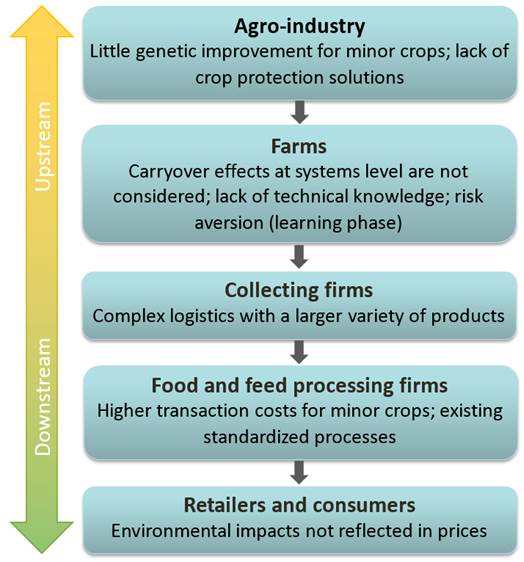In the last fifty years, rural areas and farms in France have become more and more specialized, despite the fact that there is evidence that crop diversification can largely contribute to reducing input use in agriculture (pesticides, nitrogen fertilizer, irrigation water) and related negative environmental impacts. A study carried out by INRA (Meynard et al., 2013) analysed the obstacles to crop diversification that appear at various levels of the supply chains (see diagram). This was done using two approaches:
- Interviews with stakeholders from French supply chains, to conduct a cross-cutting analysis of impediments to the development of eleven diversification crops;
- A detailed study of the value-chains and the modes of coordination between its actors. This was done for three case studies: pea and linseed for animal feed, hemp for insulation, and biomaterials.
A lock-in was identified around the dominant species, such as wheat, rapeseed, and maize, which hinders crop diversification and favours short rotations. This lock-in is caused by several inter-connected impediments, such as
- the lack of availability of crop varieties and methods of crop protection,
- scarcity of technical and economic references at the crop rotation level,
- complexity of the knowledge to be acquired by farmers,
- logistical constraints to harvest minor crops, and
- lack of coordination within the emerging supply chains.
On the basis of this lock-in analysis, that could equally concern other European countries, a series of levers were proposed to encourage actors to incorporate greater crop diversity into their productive system to foster agroecological transition.
The study proposed the simultaneous and coordinated implementation of two major categories of levers:
- Support the development of innovative niches and develop learning-for-innovation processes for the construction and consolidation of supply chain diversification via:
- Long-term partnership mechanisms between supply chain, research and development, advisory and public research actors, plant breeders and local authorities;
- Reinforcing the labelling system (primarily official quality labels);
- Sustaining technological and genetic innovation related to diversified supply chains;
- Promoting investment in the field of plant physiology, management of diversification crops and the ecological role of crop diversification at landscape level;
- Promoting an observatory to monitor minor crops and their role in cropping systems and rotations.
- Encourage the standard agricultural system to evolve and predispose it to develop diversification crops via:
- Encouraging crop diversification via regulations, e.g., under the Common Agricultural Policy (CAP);
- Promoting diversified supply chains via public contracts and regulation;
- Encouraging the reduction of inputs.
All recommendations have to be considered simultaneously and for the long-term, as sectorial measures, which target only one component of the value-chain (e.g. farmers), have largely failed.
This INRA study was a direct source of inspiration for DiverIMPACTS, which uses the same theoretical framework, further extends the case studies to address several kinds of diversification across Europe, and will go beyond the identification of barriers by co-designing practical solutions together with the actors.
Further information
Link
inra.fr: Study "Crop Diversification: obstacles and levers"
Citation
Meynard, J. M., Messéan, A., Charlier, A., Charrier, F., Farès, M., Le Bail, M, Magrini, M.B., Savini, I. (2013). Crop Diversification: Obstacles and Levers, Study of Farms and Supply chains. Synopsis of the study report, INRA.

 tap and then scroll down to the Add to Home Screen command.
tap and then scroll down to the Add to Home Screen command.